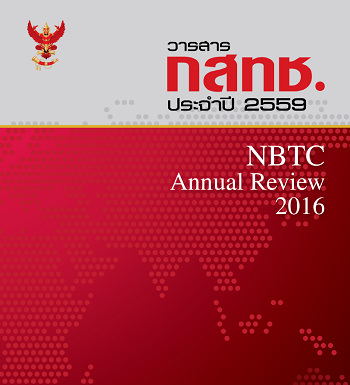ปัจจัยอะไรที่ส่งผลต่อการรับมาใช้ของบริการอินเทอร์เน็ตผ่านอุปกรณ์เคลื่อนที่และการชำระเงินแบบอิเล็กทรอนิกส์ผ่านอุปกรณ์เคลื่อนที่? ข้อสรุปจากการทบทวนวรรณกรรม
คำสำคัญ:
mobile internet, mobile payment, adoption, broadband ecosystemบทคัดย่อ
การเติบโตอย่างรวดเร็วของการรับมาใช้โทรศัพท์เคลื่อนที่แบบ smart phone ตั้งแต่ปี พ.ศ. 2553 ที่ผ่านมานั้นเปลี่ยนแปลงการใช้โทรศัพท์เคลื่อนที่จากเพียงแค่บริการด้านเสียง ไปสู่บริการอื่นๆมากมาย เช่น กล้องถ่ายรูป เครื่องเล่นเพลง และรวมถึงการใช้บริการอินเทอร์เน็ตผ่านอุปกรณ์เคลื่อนที่ (mobile internet) และการชำระเงินแบบอิเล็กทรอนิกส์ผ่านอุปกรณ์เคลื่อนที่ (mobile payment) ด้วยประโยชน์ทั้งต่อเศรษฐกิจและสังคมของ mobile internet และ mobile payment ทำให้เป็นเรื่องสำคัญที่จะเข้าใจว่าอะไรคือปัจจัยสำคัญในการใช้ mobile internet และ mobile payment บทความฉบับนี้ศึกษาถึงปัจจัยที่ส่งผลต่อการรับมาใช้ของบริการอินเทอร์เน็ตผ่านอุปกรณ์เคลื่อนที่และการชำระเงินแบบอิเล็กทรอนิกส์ผ่านอุปกรณ์เคลื่อนที่โดยวิธีการศึกษาแบบการทบทวนวรรณกรรมจากบทความศึกษาอื่นๆในช่วงทศวรรษที่ผ่านมา ผลการศึกษาพบว่าความปลอดภัย ราคา คุณภาพ และการเข้าถึงของ mobile internet และ mobile payment รวมไปถึงรายได้ อายุ การศึกษา และทัศนคติของผู้ใช้อีกนั้น มีผลต่อการใช้ mobile internet และ mobile payment ยิ่งไปกว่านั้นเมื่อนำแนวคิดในเรื่องของ broadband ecosystem มาอธิบายยังช่วยอธิบายความรู้ที่ได้จากบทความนี้ไปใช้กับนโยบายบรอดแบนด์แห่งชาติอีกด้วย
เอกสารอ้างอิง
Akimoto, A. (2011). In the battle with smart phones is i-mode dead? The Japan Times. Retrieved 2 June 2016 from
nZPl96Uk
Arthur D. Little. (2012). The business benefits of 4G LTE. Arthur D. Little. Retrieved 31 May 2016 from
https://www.adlittle.com/downloads/tx_adlreports/ADL_UK_Business_Benefits_01.pdf
Boston Consulting Group (BCG). (2011). The socio-economic impact of mobile financial services: Analysis of Pakistan,
Bangladesh, India, Serbia and Malaysia. The Boston Consulting Group. April 2011. Retrieved 4 June 2016 from
BCG-Telenor-Group-2011.pdf
Bouwman, H., Carlsson, C., Castillo, F. J. M., Giaglis, G. M. & Walden, P. (2010). Factors affecting the present and
future use of mobile data services: Comparing the Dutch, Finnish and Greek markets. International Journal of
Mobile Communications 8(4), 430-450.
Cambini, C. & Jiang, Y. (2009). Broadband investment and regulation: A literature review. Telecommunications Policy
(10-11), 559-574.
Cheong, J. H. & Park, M-C. (2005). Mobile internet acceptance in Korea. Internet Research 15(2), 125 – 140.
Chutter, M. (2009). Overview of the technology acceptance model: Origins, developments and future directions.
Sprouts: Working Papers on Information Systems 9(37), Indiana University, USA.
CISCO. (2016). Cisco visual networking index: Global mobile data traffic forecast update, 2015–2020 White Paper.
Retrieved 1 June 2016 from https://www.cisco.com/c/en/us/solutions/collateral/service-provider/
visual-networking-index-vni/mobile-white-paper-c11-520862.html
Dahlberg, T., Mallat, N. & Öörni, A. (2003). Trust enhanced technology acceptance model – Consumer acceptance of
mobile payment solutions: Tentative evidence. Stockholm Mobility Roundtable, 22-23.
Dahlberg, T., Mallat, N., Ondrus, J. & Zmijewska, A. (2007). Past, present and future of mobile payments research:
A literature review. Electronic Commerce Research and Applications 7(2), 165-181.
Dennehy, D. & Sammon, D. (2015). Trends in mobile payments research: A literature review. Journal of Innovation
Management 3(1), 49-61.
Dewan, S. & Chen, L. (2005). Mobile payment adoption in the US: A cross-industry, cross-platform solution. Journal
of Information Privacy and Security 1(2), 4-28.
European Commission (EC). (2012). Green paper - Towards an integrated European market for card, internet and
mobile payments. Brussels. COM(2011) 941 final. Retrieved 31 May 2016 from https://eur-lex.europa.eu/legal-
content/EN/TXT/PDF/?uri=CELEX:52011DC0941&from=EN
Flood, D., West, T. & Wheadon, D. (2013). Trends in mobile payments in developing and advanced economies.
Reserve Bank of Australia. Bulletin March Quarter 3, 71-79.
Forge, S. & Bohlin, E. (2008). Managed innovation in Korea in telecommunications – Moving towards 4G mobile at a
national level. Telematics and Informatics 25, 292-308.
Fransman, M. (2007). Innovation in the new ICT ecosystem. Communication & Strategies 68, 89-110.
Funk, J. L. (2005). The future of the mobile phone internet: An analysis of technological trajectories and lead users
in the Japanese market. Technology in Society 27(1), 69-83.
Gruber, H. (2005). The economics of Mobile telecommunications. Cambridge: Cambridge University Press.
Hill, S. R., O’Doherty, K., Mackay, M. M. & McPherson, J. (2010). Mobile data service usage and preference: An
investigation of Australian consumers. International Journal of Mobile Communications 8(1), 106-127.
ITU. (2012). Impact of broadband on the economy. Broadband series. Telecommunication Development Sector.
ITU, Geneva.
Kongaut, C. & Bohlin, E. (2015). Towards broadband targets on the EU Digital Agenda 2020: Discussion on the
demand side of broadband policy. Info 17(3), 1-15.
Kongaut, C. & Bohlin, E. (2016). Investigating mobile broadband adoption and usage: A case of smartphones in
Sweden. Telematics and Informatics 33(3), 742-752.
Okazaki, S. (2006). What do we know about mobile internet adopters? A cluster analysis. Information and
Management 43(2), 127-141.
Pousttchi, K. (2003). Conditions for acceptance and usage of mobile payment procedures. Proceedings of the
International Conference on Mobile Business (ICMB 2003), 23-24 June 2003, Vienna.
Prieger, J.E. (2013). The broadband digital divide and the economic benefits of mobile broadband for rural areas.
Telecommunications Policy 37(6-7), 483-502.
PTS. (2004). The Swedish Telecommunications Market 2003. Stockholm. Retrieved 30 May 2016 from
https://www.pts.se/upload/Documents/EN/sv_telemarknad_03_eng_2.pdf
Raja, S., Kim, Y. & Kelly, T. (2010). Building broadband: Strategies and policies for the developing world. Global
Information and Communication Technologies Department of World Bank, Washington D.C.
TeliaSonera. (2010). TeliaSonera Annual report 2009. Retrieved 1 Jun 2016 from https:// www.teliacompany.
com/globalassets/telia-company/documents/reports/2009/annual-report/ teliasonera-annual-report-2009-en.pdf
Thompson Jr., H.G. & Garbacz, C. (2011). Economic impacts of mobile versus fixed broadband.
Telecommunications Policy 35(11), 999-1009.
Schierz, P. G., Schilke, O. & Wirtz, B. W. (2010). Understanding consumer acceptance of mobile payment services:
An empirical analysis. Electronic Commerce Research and Applications 9(3), 209-216.
Srinuan, C., Srinuan, P. & Bohlin, E. (2012). An analysis of mobile internet access in Thailand: Implications for
bridging the digital divide. Telematics and Informatics 29(3), 254-262.
Statista (2016). The Statistics Portal. Retrieved 13 Jun 2016 from https://www.statista.com/
Valant, J. (2015). Consumer protection aspects of mobile payments. European Parliamentary Research Service
(EPRS), Members' Research Service, PE 564.354. Retrieved 8 June 2016 from https://www.europarl.
europa.eu/RegData/etudes/BRIE/2015/564354/EPRS_BRI(2015)564354_EN.pdf
Viehland, D. & Leong, R. S. Y. (2007). Acceptance and use of mobile payments. Proceeding of 18th Australasian
Conference on Information Systems, 5-7 December 2007, Toowoomba.
Vodafone. (2013). A brief history of mobile data: The road to the next generation. Retrieved 1 June 2016 from
https://blog.vodafone.co.uk/2013/01/21/a-brief-history-of-mobile-data/
Westlund, O. & Bohlin, E. (2008). Mobile internet adoption and use: Results from a national survey in Sweden.
Proceeding of the International Telecommunications Society 17th Biennial Conference, 24-27 June 2008,
Montreal.
Zmijewska, A., Lawrence, E. & Steele, R. (2004). Towards understanding of factors influencing user acceptance of
mobile payment systems. Proceeding of IADIS International Conference WWW/Internet 2004, 6-9 October 2004,
Madrid.
ดาวน์โหลด
เผยแพร่แล้ว
รูปแบบการอ้างอิง
ฉบับ
ประเภทบทความ
สัญญาอนุญาต
บทความที่ปรากฏในวารสารกิจการสื่อสารดิจิทัล เป็นลิขสิทธิ์ของสำนักงาน กสทช. ซึ่งสำนักงาน กสทช. เปิดโอกาสให้สาธารณะหรือบุคคลทั่วไปสามารถนำผลงานไปเผยแพร่ คัดลอก หรือตีพิมพ์ซ้ำได้ ภายใต้สัญญาอนุญาตแบบเปิด (Creative Commons: CC) โดยมีเงื่อนไขสำหรับผู้ที่นำผลงานไปใช้ต้องระบุอ้างอิงแหล่งที่มา (Attribution: BY) ห้ามดัดแปลง (NoDerivatives: ND) และต้องไม่ใช้เพื่อการค้า (NonCommercial: NC) เว้นแต่ได้รับอนุญาตเป็นลายลักษณ์อักษรจากสำนักงาน กสทช.
อนึ่ง ข้อความ ตาราง และภาพที่ปรากฏในบทความซึ่งได้รับการตอบรับให้ตีพิมพ์และเผยแพร่ในวารสารนี้เป็นความคิดเห็นของผู้นิพนธ์ โดยไม่ผูกพันต่อ กสทช. และสำนักงาน กสทช. หากมีความผิดพลาดใด ๆ ผู้นิพนธ์แต่ละท่านต้องรับผิดชอบบทความของตนเองแต่เพียงผู้เดียว ไม่เกี่ยวข้องกับ กสทช. และสำนักงาน กสทช. แต่ประการใด



